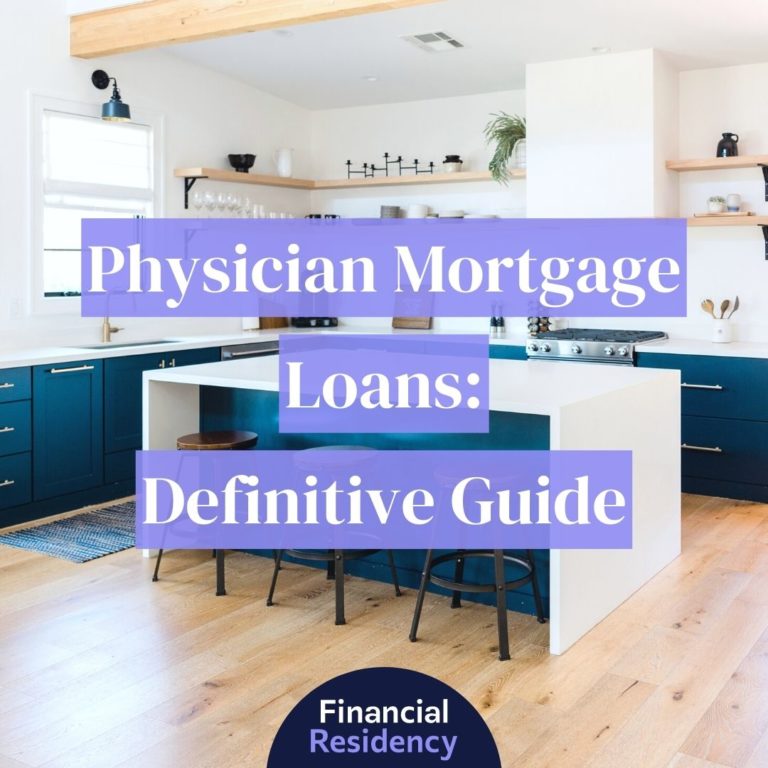One of the most common questions we get asked here at Financial Residency is: “how much home can I afford?” and “how does a physician mortgage help?”
It’s an important question for physicians to ask. While other professional fields involve taking on a high level of debt, physicians typically spend years working steadily toward a particular career to the exclusion of other activities, which can impact income.
It’s understandable that the single most expensive purchase you will likely ever make is daunting. Doing the research to fully understand how mortgage loans work can make all the difference when it comes to choosing a home that best suits your needs, including and especially when it comes to price.
With all things finance-related, there is plenty of practical advice available, but the bottom line for how much house you can afford is all about your comfort level of spending and your personal goals.
Determining the right amount of mortgage for you may feel daunting when you work in a field that comes with so much student loan debt, but by taking a cold, hard look at the facts when it comes to personal finance, we are confident you can find determine just how much home you can afford.
How Is a Physician Mortgage Different Than Other Mortgages?
Big picture, a physician’s mortgage is exactly the same as anyone else’s. You borrow money to buy a home. You choose a lender and they review your finances. Once you settle on the best deal for you, you buy the home.
You then make a monthly payment for the life of the loan.
At its simplest, a mortgage does one important thing: puts a roof over your head. The reality of home ownership is a bit more complicated because owning your own home also helps you build equity, which is the amount of the purchase price of your home you have already paid.
For example, if you buy a $300,000 home and put 20% down as a down payment, you have 20% equity in your home, meaning you own the value of $60,000 worth of your real estate.
Every month, you build a bit more equity, which in turn means you have a bit more financial stability with this investment because you are that much less beholden to the bank.
Physician’s Mortgages vs. Other’s Mortgages:
- Higher Levels of Income: Physicians, on average, earn $313,000 per year in the United States, compared to the average household income of $97,962. Those are two very different numbers and show at a glance why physicians are considered a good risk for a lender.
- Higher Levels of Debt: Lenders know that statistically speaking, physicians have a much lower default rate than the rest of the public, given their ability to be well-employed. Lenders who specialize in working with physicians will help you find the right mortgage loan despite your student loan debt.
- Shorter Credit History: Because physicians spend most of their adult years working towards becoming physicians, it’s not uncommon to have less of a credit history than the general public.
- Lower or Non-Existent Credit Score: See “shorter credit history” above. Do not worry. Lenders will take this into account due to your specialized employment and education history.
Learn More:
How to Figure Out How Much House You Can Afford
So, the big question is: how much house can you really afford? There is no quick, short answer to this question.
While there are plenty of free online loan calculators that will tell you how much your monthly payment is with different variables, at the end of the day, how much money you are comfortable spending on that roof over your head is up to only one person: you.
To be sure, two people earning the same amount of money, living in the same part of the country, with the same size families, might have two very different thresholds for what they are willing and feel able to spend on housing every month.
That’s why it’s important to look at your financial situation and goals in a big-picture way to find the best answer for you as to how many houses you can afford to buy.
Lenders Offer More Than You Might Wish to Borrow
The one place you should not start when considering how much house you can afford to buy is with what your lender is willing to loan you.
Mortgage lenders make money off of the interest on your loan. The more money you borrow, the more money you make.
They are not being dishonest in offering you a high amount to borrow, but it is important to remember that just because the money is available to you, doesn’t mean it’s in your best interest to borrow the full amount.
Consider all Possible Variables:
- Principle: This is the purchase price of the home
- Interest: This is the fee you pay to the bank for the privilege of borrowing the money you need to buy the home
- PMI: Prime Mortgage Insurance is an extra fee that lenders will charge for most borrowers who make a down payment of less than 20%. Most lenders specializing in mortgage loans for physicians will waive PMI.
- Insurance: Everyone must carry homeowner’s insurance to protect the investment of their home. This includes the structure of the home itself as well as the contests. You’ll buy an insurance policy separately from your home loan but can often roll the costs of your insurance premiums into your mortgage payment for one convenient monthly payment.
- Utilities: Don’t underestimate the impact of utilities on your monthly budget. It costs a lot more to heat or cool a bigger house, and water bills and insurance are different depending on factors such as a pool or geographic location.
- Repairs and Maintenance: Protect your investment and be prepared to keep appliances in working order, have the HVAC system properly maintained, repair or replace the roof at some point, and the list goes on. Estimate one to three percent of the purchase price of the home in repairs every year.
- Furniture and Other Household Items: Many people forget that once you have a home, furniture, blinds, and other household items do not magically appear. It can cost a lot to furnish a home if you aren’t bringing household goods with you.
- HOA Fees: Be sure you knew these fees before purchasing your home. Many homes do come with a homeowner’s association fee that may cover things such as property landscaping, insurance for the property as a whole, and any amenities to which you may have access, such as a pool or fitness center. Those fees can really affect your monthly payment so be sure you know what you’ll be charged because they are not negotiable should you choose to buy in a particular building or housing development.
- Closing Costs: These are fees paid one time to the lender at the time of closing the loan. They can often be negotiated, so be sure to ask your lender for a complete list of fees prior to purchase.
- Household Income: Consider your income and that of any other wage earners in your home, such as a partner or a spouse.
- Monthly debts: What other money do you owe? Student loans are probably your biggest debt, but also consider your car payment, credit card payments, cell phone, and any other fixed expenses.
- Savings Available for a Down Payment: As a physician, you might need little or no money for a down payment to get into a home, but it’s a good idea to know how much cash you have available for a down payment should you wish to use that to reduce your monthly payment once you have the loan.
- Child Support: This is a fixed monthly expense that you should be sure to consider when determining your monthly budget.
- Property Taxes: Taxes can, and do, vary widely state-to-state, and county to county. Be sure to take a look at the average taxes of the homes in the geographic area where you use to live. That money is typically due bi-annually and can be rolled into your monthly mortgage payment.
- Cost of Living: different geographic locations have different costs of living. You will spend much more money for much less house in New York City than you will in any midwestern town, for example.
- Personal Comfort Level: This is the big one. While the numbers associated with an HOA fee or property taxes are outside of your control, you are the sole person who gets to decide your comfort level in terms of how you balance your budget.
- House rich versus house poor: You may prefer a nicer home even if that means less money in your pocket, or you may prefer to save as much as possible so you can use that money for other things, even if that means living in a smaller or older home. The choice is yours.
- Rainy day fund: It’s not a bad idea to have a bit of money put aside in a savings account separate from your regular savings so you can weather the things that life inevitably throws your way, such as emergency car repairs, health concerns, and all manner of the unexpected.
- Savings for other financial goals: What else do you hope to accomplish in the long term? Do you want to save up to purchase an investment property, or to invest in starting your own medical practice? Do you have dreams of international travel?
How to Calculate How Much House You Can Afford
There is a multitude of free mortgage calculators available online. Simply plug in a sample purchase price, and you can play around with how your monthly payment would change if you raise or lower your down payment, have higher or lower taxes, and so forth.
Of course, this type of calculator only provides a small part of the picture. Check-in with your financial advisor can help you see the bigger spread in terms of how to factor in all of the items listed above, especially including student loan debt.
36% Rule
A general rule of thumb to ensure you are not borrowing more than you can realistically afford is to use the 36% rule.
This says that housing expenses should not exceed 36% of your gross monthly income. Gross income is what you are paid prior to any deductions.
Those monthly expenses should include your entire debt: potential mortgage payments, car payments, credit card debt, student loans, and other monthly payments.
However, being a physician means you can adjust that number with regard to student loan debt because there are lenders who will agree not to include them in the calculations for what you can afford. This is where meeting with your financial advisor can really benefit you.
25% Rule
Some financial advisors advocate for a 25% rule, others for a 28% rule, but either way, the idea is to divide your take-home pay – or net pay – by .25 (or .28, if you’re going by 28%), to get the number that best fits your budget.
Know Your Options
As a physician, you have more options for a mortgage loan than most people. You will likely be able to secure a mortgage loan without a down payment, and without paying PMI.
These are great benefits! Once you determine a monthly payment where you’re comfortable, consider also the length of the loan.
30-Year
A 30-year loan is known as a conventional loan for a reason. Just because the loan is spread out over a 30-year period does not mean you have to stay in the home for thirty years. That period of time is simply how the principle and interest are calculated so that you can have a reasonable monthly payment for the home in which you live. You can sell the house anytime, and in doing so, pay back the loan.
A 30-year mortgage typically has a fixed interest rate, which means that your monthly payment does not change year over year. If interest rates go up nationwide, you are safe because you are locked in a lower rate. If interest rates decline, you will not be able to take advantage of them unless you refinance the loan. This means you take out a new mortgage to replace the old one, along with the closing costs that come with processing a mortgage loan.
15-Year
It’s also possible to take out a fixed-rate loan for 15 years instead of 30. That will generally result in a lower interest rate but higher monthly payments. This is generally not the best option if you are a resident and know you will only be in the home for 5-7 years.
Adjustable Rate Mortgage (ARM)
An adjustable-rate mortgage, known as an ARM, could be a great option if you know you won’t be in the home long-term. Just as the name would imply, every year, the interest rate on an ARM can adjust, higher or lower. This means that your monthly payment could go up or down on an annual basis.
For someone in a home long-term, the variable might be stressful. But if you will only be in the home for 5-7 years due to residency, you can take advantage of the lower interest rate that you get up front and can ride out any fluctuations in the market that may come later because you will have sold the home.
Build Your Team
Once you have determined how much home you can comfortably afford, make sure you have the right professionals around you.
A buyer’s agent will help you find the right house in your price range. That person can also help you negotiate to get the best price for the market, and not overpay.
Your financial advisor can help you see the big picture. This person will help you devise a plan so you can pay off your loans and still enjoy the benefits of homeownership.
The lender’s job is to present different options for financing that are available to you as a physician. They can provide calculations as to how different interest rates and types of loan products will affect your bottom line: the monthly payment.




